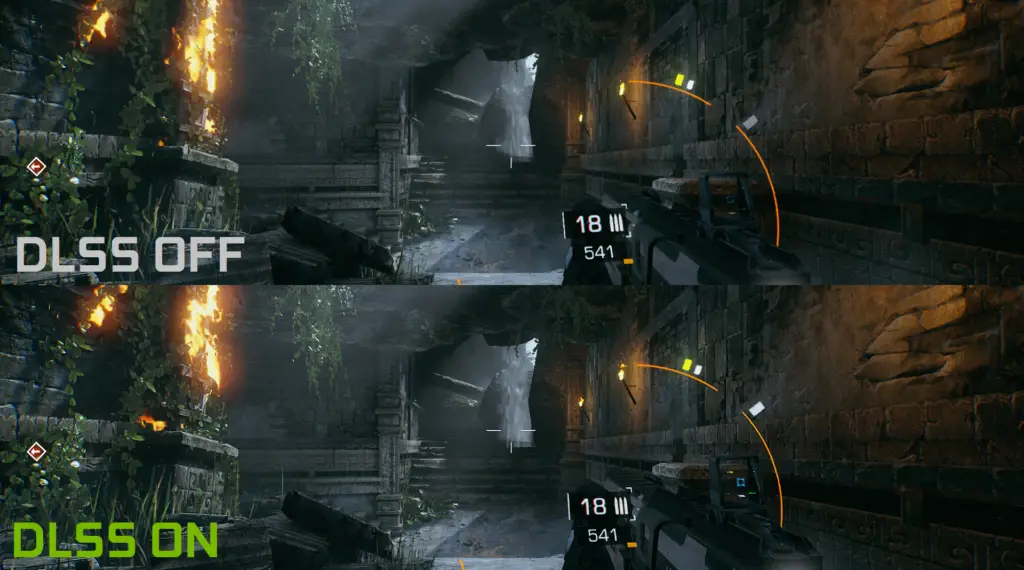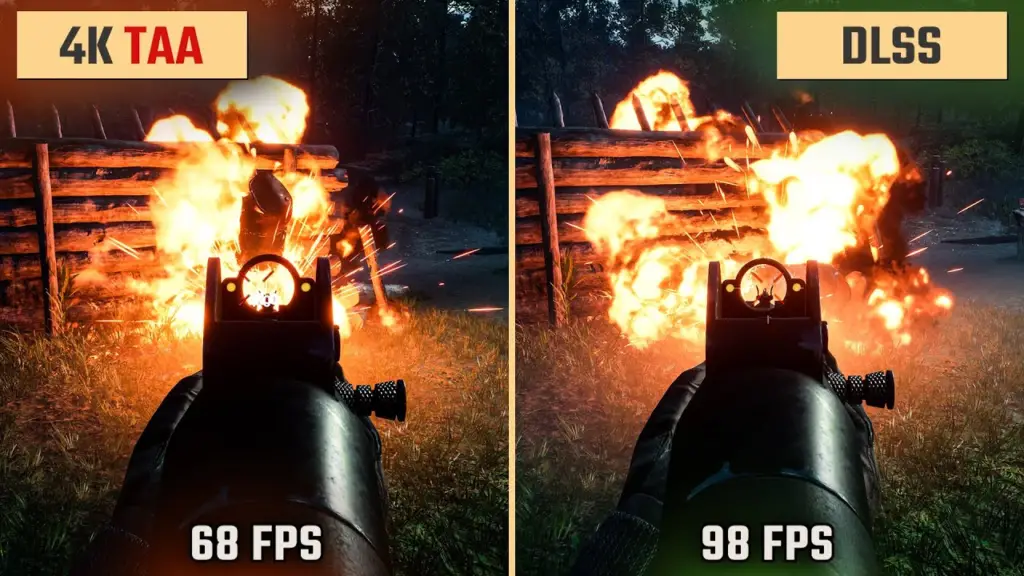Many people question the implementation of DLSS and TAA in games like Microsoft Flight Simulator. I spent a little time in that conundrum as well. It took only a little time because the winner of DLSS vs TAA is apparent.
DLSS is far better than TAA as it boosts the FPS in games like MSFS without any apparent loss in visual quality. TAA is relevant for GPUs that do not support DLSS and for games that have blurry textures with DLSS.
I know that’s not enough for you to come to a conclusion just yet. So, I’ve done my own analysis on both TAA and DLSS. Here’s what I found-
DLSS vs TAA: Differences at a Glance
DLSS has better visual fidelity, FPS, and higher requirements compared to TAA in most cases. However, there are exceptions.
| Aspect | DLSS | TAA |
| FPS | 10-100% Higher | Lower |
| Visuals | Generally Sharper | Generally Blurrier |
| Requirements | Requires RTX 2000+ GPU | Available on Most GPUs |
These numbers might confuse you now, but I’ll go into more details now to make it easier for you.
DLSS vs TAA: In-Depth Comparison
DLSS has 10-100% higher FPS, Sharper Visuals, and steeper requirements compared to TAA.
Unlike when it comes to DX11 vs DX12, the differences are more pronounced between DLSS and TAA.
Here is how these translate to differences in usage for you-
Visuals:
Deep Learning Supersampling or DLSS uses AI to upscale images to higher resolutions Which gives it an edge over TAA in terms of fidelity.

However, the difference is not obvious to the eyes in most cases. Furthermore, visuals look worse in some exceptionally rare cases. For example, textures and shadows look a little blurry with DLSS on in Read Dead Redemption 2.
TAA, on the other hand, uses an algorithm to improve visuals in games. This is the traditional technology and has been the standard for many years. It improves the visuals by reducing the noise from pictures and still one-ups the DLSS in some cases.
So, the winner, in this case, is DLSS for the most part. TAA, however, is not far behind DLSS.
FPS:
DLSS has an absolute advantage over TAA in the FPS department. TAA uses algorithms to improve visuals, while DLSS uses separate engines to do so. That allows DLSS-enabled GPUs to push higher FPS compared to TAA.
Furthermore, DLSS 2.0 provides a 10-20% FPS boost, and DLSS 3.0 is capable of boosting FPS to up to 100% even.

On the other hand, TAA uses algorithms that place pressure on the processing power of the GPU. That results in the GPU being able to push out much lower FPS than expected.
Requirements:
DLSS has much steeper requirements compared to TAA. DLSS requires accelerator units that are unique to the RTX lineup of Nvidia graphics cards. Other GPUs will not support DLSS.
On the other hand, TAA does not require any specific hardware for improving visuals. So, most GPUs, irrespective of the brand, can use TAA, including those that can use DLSS as well.
These differences clearly place DLSS over TAA in practical situations. However, to make it even clearer for you, I will provide some in-game examples.
The Difference between DLSS and TAA in Games
The difference between DLSS and TAA in games ranges from 10-20% generally. The number goes up with Nvidia 4000 series GPUs and DLSS 3.0.
Without further ado, I’ll move on to a detailed analysis.
DLSS vs. TAA: MSFS
When it comes to MSFS, DLSS introduces a sharp boost to FPS of around 20% compared to TAA.
In effect, with a 3060ti GPU, you can typically expect 45-50 fps on average with TAA at 1080p. However, you’ll get around 60 fps if you switch to DLSS. That number differs with the GPU you’ll use, but the boost is around 20% in most cases.
Furthermore, you’ll get this boost at no apparent losses of visual fidelity. To tell the difference, you’d have to zoom a lot, but that doesn’t make any sense.
So, for Microsoft Flight Simulator, you’re better off using DLSS instead of TAA. No one says no to free performance, after all.
DLSS vs. TAA: RDR 2
In RDR 2, DLSS can provide a 50% boost to FPS. To be more specific, RDR 2 gets around 30 FPS with the RTX 2080 at 1080p, whereas with DLSS turned on, you’ll get double that of around 60 fps. That is a massive increase. However, it comes at a rather steep cost.
The textures of RDR2 get blurry with the use of DLSS, according to many players of the game. The textures are noticeably blurry even to the naked eye without zooming in at all.
So my verdict for this game would be that unless you absolutely need the extra FPS, do not go for DLSS with RDR 2.
DLSS vs. TAA: Dead Space
Similar to MSFS 2020, Dead Space has a higher FPS on DLSS compared to TAA. However, the increase, in this case, is far more compared to the MSFS.
With a 3060ti, Dead Space gets 90 FPS on average when using TAA at 1080p. However, that increases to around 135 FPS on DLSS. That’s a 50% FPS increase with no apparent loss to the visuals.
So, do use DLSS with Dead Space if the option is available to you. You will not regret it.
DLSS vs. TAA: Horizon Zero Dawn
For Horizon Zero Dawn, You’ll have a 10-15% FPS increase at the cost of slightly blurry textures when zoomed in if you use DLSS.
Horizon Zero Dawn is more of a mixed bag with its slightly blurry textures compared to the sharp TAA. So I’d recommend using TAA with Horizon Zero Dawn if you want the maximum visual quality.
However, you likely won’t notice the blurry textures with the DLSS even if you do choose to use it. So, this one’s your choice.
Now that all is said and done, it’s time to make a decision.
So Which One Should You Go For?
You should go for DLSS in any case. Not only does it do wonders for MSFS, it snags an easy victory from TAA for most games, if not all.
To be more specific, If you do have a GPU that supports DLSS, then absolutely use the technology to the fullest.
Furthermore, if you have the technology, you can easily switch between TAA and DLSS, so a simple click of a button is all it will take for you to get the extra performance. However, to enjoy these features in games like msfs, make sure your game is even using the GPU.
I will now answer a few of the frequently asked questions before concluding the article with a few final words.
Frequently Asked Questions (FAQs):
What’s a Good DLSS alternative?
The closest good DLSS alternative is AMD FSR2. Primarily because FSR2 is available on every GPU, it’s not bound to any series of GPUs. That aside, there are other implementations of supersampling, but I would not recommend them.
What version of DLSS is best?
From a technical standpoint, DLSS 3.0 is the best version of DLSS. However, the 40-series is pretty expensive and hard to get. So, I would recommend you get DLSS 2.3, the second-best version which is available in the other lineups of RTX series cards.
Do All Nvidia GPUs Support DLSS?
No, all Nvidia GPUs do not support DLSS. To be more specific, only Nvidia RTX series GPUs support DLSS. So, 20,30, and 40-series GPUs.
Final Words
That’ll be all for today. I hope I was able to point out the winner of the DLSS vs TAA fight. So, will you use TAA or will you use DLSS next session? Let me know in the comments below.
Till then, happy gaming!
